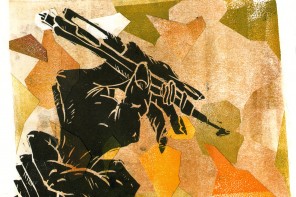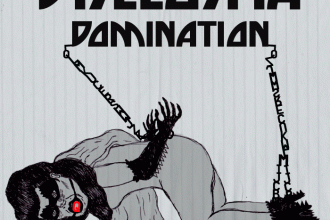Making love and war: ‘The East’ and the duality of protest
The recent wave of popular protests, in Brazil and worldwide, has divided public opinion concerning the most appropriate method of action. Some think there should be no place for so-called acts of “vandalism” in public demonstrations, while others believe it is only through these acts that the message will be effectively conveyed. The newly released film ‘The East’ deals precisely with this opposition of ideas, suggesting the primacy of the former over the latter. This way of looking at things, however, reinforces a strict dichotomy between “vandalism” and “non-violence” that is likely to do more harm than good. If we have any hopes of raising a genuinely new and radical form of political activism, we need to abandon this opposition and acknowledge both of these ideas as two sides of the same coin, which complement rather than oppose one another.
There has been a massive wave of popular protests in Brazil in the last few months. What started as an isolated reaction against the price of public transport has expanded so as to cover a wide range of issues, such as the excessive public spending on the upcoming World Cup, the proper demarcation of indigenous lands, the impunity of corrupt politicians, and so on. And as the protesters clashed with the excessive brutality of the military police, people fought back, and conflict escalated to a whole new level. Whereas in the past only the most radical of activists would go to a public protest wearing a gas mask, these days even reporters of the mainstream media can be seen parading the streets in warfare protection gear. Every act of public demonstration is virtually guaranteed to lead into violent clashes with the police.
Of course, this is hardly news to those who had been already demonstrating in the streets long before the media-friendly protests of today. But to the large portion of the middle class who has just discovered the streets as a political arena, police brutality came as a shock, an act of senseless violence that bears on unintelligibility. Why, they think, deploy so much violence against a form of public demonstration that is essentially peaceful?
But this last point is controversial. To the older and more radical protesters who are well accustomed to police brutality, it is far from clear that protests are essentially peaceful events. In fact, many of the methods and strategies deployed today in public demonstrations have been developed as a direct response to police oppression, different ways of fighting back and avoid getting hurt while simultaneously getting one’s message across. And sometimes these strategies might involve what the media confusingly refers to as ‘vandalism’ – a term intentionally deployed with negative connotations, but that we can understand here in neutral terms as an act that directly causes permanent changes in the physical structure of the city – graffitting, stoning the façades of the big banks, burning buses, and so on.
The question of whether there is any place for vandalism in public demonstrations has attracted a lot of attention in the Brazilian social and alternative media, and has divided the sphere of political activism into two groups diametrically opposed to one another. On the one hand there are those who vehemently oppose any kind of action that could be called “vandalism”; on the other, there are those who feel that real change will come only when we take back the streets and alter the physical structure of the city. The first group, easily recognizable by their shouts of “no violence” during the protests, began to be identified with an alienated middle class accused of political naiveté, while the second group was identified with a more radical stripe of activism, accused of employing ineffective and outdated methods of action. Both groups ultimately wanted the same thing but could not agree on how to obtain it, sometimes even turning against one another: during a protest in the city of Belo Horizonte, a member of the first group went as far as collaborating with the police in the arrest a protester belonging to the second group, who was graffitiing a wall.
Interestingly, at the same time the protests were taking place in Brazil the political film ‘The East’ was released in theaters all over Europe, which depicts the same underlying theme: the opposition between ‘vandalism’ and other, less violent forms of political activism. The film follows the footsteps of Sarah Moss, an ex-FBI agent now working for a private intelligence company, as she goes undercover and infiltrates a mysterious anarchist organization called ‘The East’. The organization follows some kind of “an eye for an eye, a tooth for a tooth” philosophy, seeking to give back to the big corporations the exact same damage they have caused to the world. The message conveyed by the group in the film’s opening scenes is clear: “lie to us, we’ll lie to you; spy on us, we’ll spy on you; poison us, we’ll poison you.”
In this manner, the group manages to fill with oil the house of a CEO of a big oil company, which was directly responsible for a massive oil spill in the ocean; soon after, the head of a pharmaceutical company that intentionally released a drug with life-threatening side effects, unknowingly gets a taste of her own medicine hidden in a champagne glass; and so on.
As the film unfolds and The East continues with its actions, the viewer cannot help but sympathize with the group. The idea behind “poison us, we’ll poison you” feels right in the context of the movie, specially when directed at corporations who have shown nothing but disregard for public and environmental concerns. And although the members of the group remain unaware that their newest member is in fact an undercover agent, Sarah begins to sympathize with the group’s agenda, and is eventually taken over by a genuine desire for change. Nevertheless, she remains strongly opposed to the group’s preferred method of action. As she says in a discussion with another member of the group, “if we resort to violence then we are no better than them.”
Now, to give the reader a little background, director Zal Batmanglij and co-writer Brit Marling (who also plays agent Sarah Moss in the film) have spent two months with a group of anarchist activists in order to get inspiration for the movie. This experience must have caused a strong impression in the writers, who paint a picture of the activists as a loving, caring and playful group of people, who are overtly affectionate with one another in an almost innocent, child-like manner. And it is exactly this dimension of political activism which the writers have chose to emphasize in their film: a novel way of loving, playing, eating, creating and engaging in human relationships. With such a beautiful message, why spoil it with acts of violence and “vandalism”?
Indeed, it is during one of these acts that the strategy misfires and a member of The East becomes seriously injured. After that, the group becomes divided, fighting with one another and putting an end to their neo-hippie honeymoon. The disagreement over the group’s tactics reaches its climax towards the end of the film, when Sarah, now completely persuaded by the group’s message, part ways with Benji, her romantic interest and a sort of spiritual leader of the group. For while Benji seeks to perpetuate the group’s “an eye for an eye, a tooth for a tooth” politics, Sarah has a different idea: what if instead of engaging in acts of violence we try talking to people in an open and honest manner? After all, the message of anarchist activism that has captivated the writers is so powerful that merely showing it people should be enough to make them believe it.
As Sarah pursues her non-violent strategy the film ends in a hopeful tone, showing newspaper headlines that indicate her success in changing the world without having to resort to violence. Seen in this light, ‘The East’ is an attempt to paint a more humane picture of a brand of radical activism that began to gain attention everywhere on the planet, highlighting the beauty of their message and the potential it holds for a truly revolutionary way of engaging in interpersonal relationships. We need not fear them, the film tells us, because there is nothing violent about them. They are only teaching us about love.
It is, however, unfortunate that the film chooses to emphasize this message within a dualist view of political activism, in much the same way as political activism in Brazil has become divided into the two groups mentioned before. This way of looking at things only reinforces a strict dichotomy between “vandalism” and “non-violence”, one that is likely to do more harm than good. People should not be given a choice of either focusing on the revolutionary power of love and interpersonal relationships, or on going to the streets and doing whatever is necessary to get their message across. On the contrary, if we have any hopes of raising a genuinely new and radical form of political activism, we need to acknowledge both of these methods as two sides of the same coin, which complement rather than oppose one another. Different circumstances will call for different courses of actions, and we need to be sensitive to when to deploy one strategy or another, or when to create a new strategy altogether.
But when we construe these different strategies as being diametrically opposed to one another we take a step backwards, and perpetuate a dichotomy that imposes a false choice between being a vandal or a loving pacifist. On the contrary, what we need is learn how to be a little bit of both: to fight social injustice in an effective manner with whatever means we have at our disposal, at the same time that we focus on taking our interpersonal relationships to a new level.
Dividing these two ideas is easy, as ‘The East’ and the mainstream media have repeatedly shown us; the challenge that now faces us is how to bring them together again.







